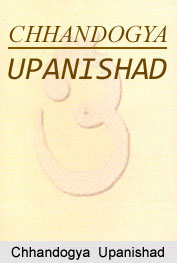 Chandogya Upanishad is one of the oldest Upanishads that is related to the Sama Veda. It is the part of Chandogya Brahaman that has been written on the Vedic Brahmana period. It is regarded as one of the primary upanisdhads. The 14th Khanda of second chapter of Chandogya Upanishad states about the meditation on the Brihat Saman. Here the syllable Him is the rising of the sun, the Prastava is the risen sun, the Udgitha is the mid day sun, the Pratihara is the afternoon sun and the Nidhana is the setting sun. It is the Brihat Saman as interwoven in the sun. One who is aware of this and realises the Brihat Saman as interwoven in the sun becomes radiant and bestowed with a good appetite. He lives happily and leads his life completely. He also receives respect among his children and family members and owns cattle. He receives name and fame from everyone.
Chandogya Upanishad is one of the oldest Upanishads that is related to the Sama Veda. It is the part of Chandogya Brahaman that has been written on the Vedic Brahmana period. It is regarded as one of the primary upanisdhads. The 14th Khanda of second chapter of Chandogya Upanishad states about the meditation on the Brihat Saman. Here the syllable Him is the rising of the sun, the Prastava is the risen sun, the Udgitha is the mid day sun, the Pratihara is the afternoon sun and the Nidhana is the setting sun. It is the Brihat Saman as interwoven in the sun. One who is aware of this and realises the Brihat Saman as interwoven in the sun becomes radiant and bestowed with a good appetite. He lives happily and leads his life completely. He also receives respect among his children and family members and owns cattle. He receives name and fame from everyone.
This article is a stub. You can enrich by adding more information to it. Send your Write Up to [email protected]



















